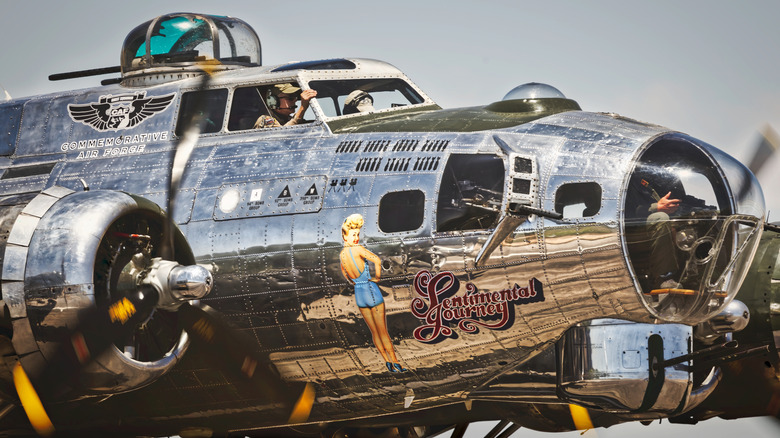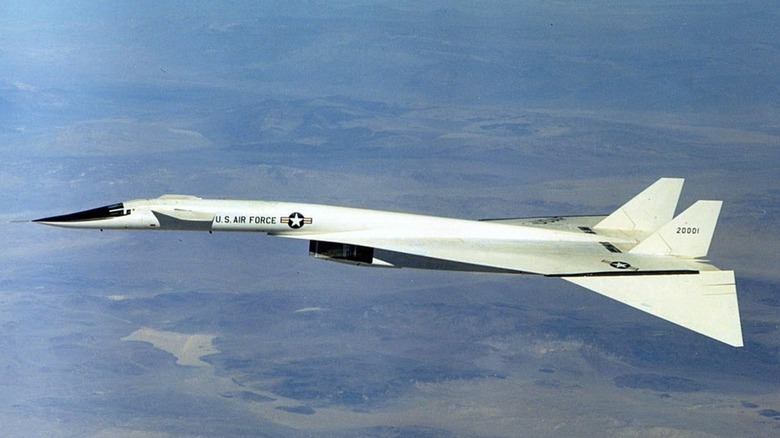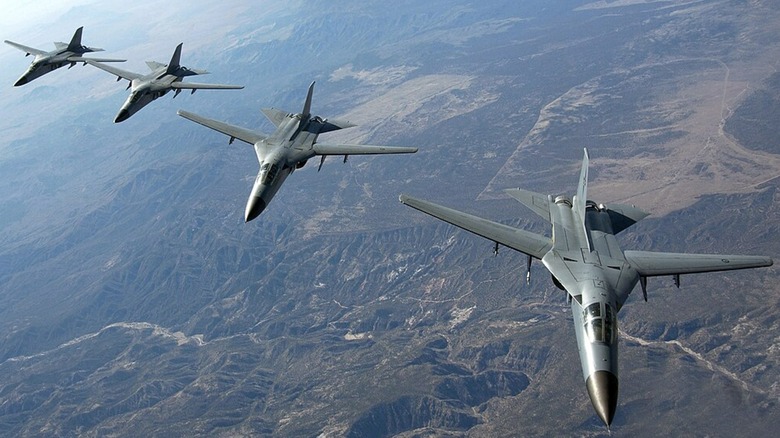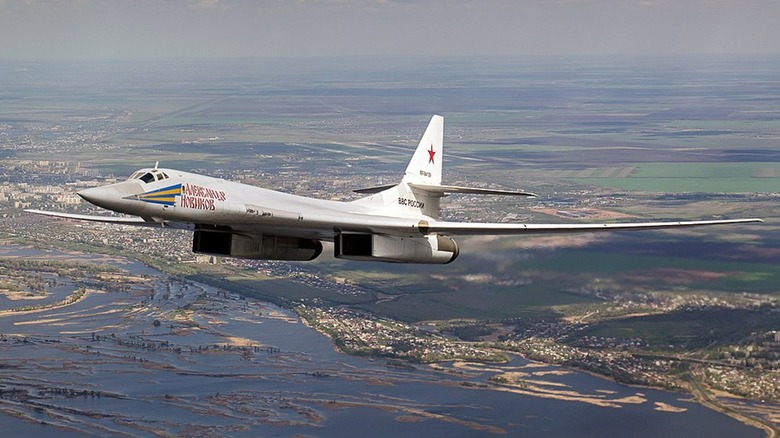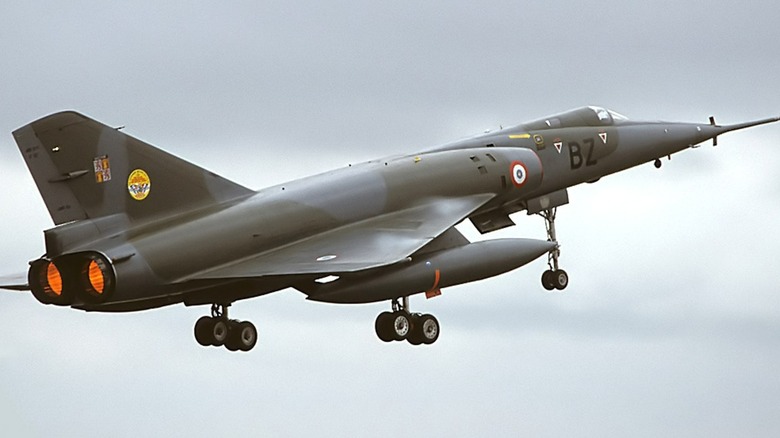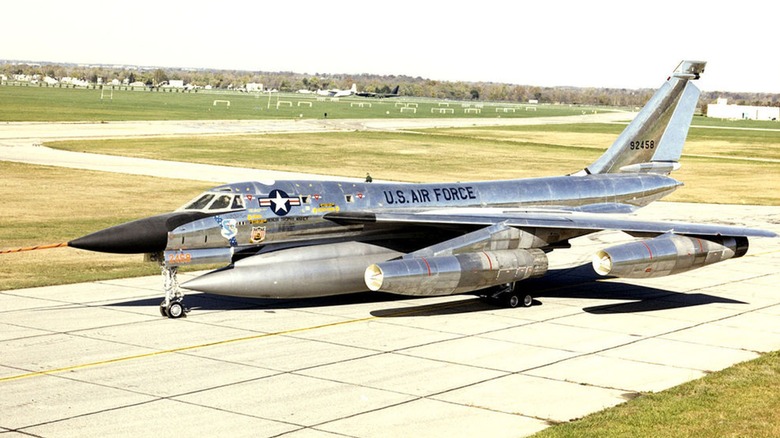5 Of The Fastest Bomber Planes, Ranked By Top Speed
The bomber is a menacing sight for any pilot or target on the receiving end of its payload. Aerial combat is only around a century old, but it quickly bisected itself into two distinct aircraft types. Modern military aircraft feature all manner of support services but the practice of taking war to the skies came into its own as aerial dogfighting and ground bombing exercises. Bombers have been at the forefront of what air forces have tasked themselves with since the concept of an aerial force came into being.
Aerial bombing was, in its infancy, a harrowing task. These aircraft were lumbering, sky-bound cargo equipment built to drop huge payloads. They completed with little in the way of maneuverability, speed, or defensive capabilities. It was therefore the responsibility of fighter pilots to protect ground assault aircraft and escort them to their targets. But this changed after World War II. The B-24 Liberator was introduced to the war effort in 1941 and could reach ground speeds of 290 mph. Then, 30 years later, in the 1970s, the B-1B Lancer prototype bomber was designed as a replacement for the B-52 and could reach Mach 2.2 (1,688 miles per hour). Another prototype that never made it into full production was the Russian Sukhoi T-4, an aircraft project canceled in 1975 but reportedly capable of reaching Mach 3 (1,988 MPH). The bomber has come a long way in a short time, ironically making pilots safer and their enemies on the ground much less so in the process.
North American XB-70 Valkyrie
North American Aviation was an aerospace company that was at the bleeding edge of many potent technologies related to flight. While the brand went defunct in the 1960s, it's actually owned by Boeing through a series of acquisitions and corporate mergers. To this day, the fastest bomber on the face of the Earth is a North American design, even though it never actually took to the skies with its explosive payload onboard. The XB-70 Valkyrie was developed in the 1950s to act as a nuclear strike solution with a lightning fast pace. The plane could reach Mach 3.1, or 2,056 miles per hour. This makes it the fifth fastest aircraft to be constructed, behind the likes of North American's breathtaking X-15 (a spaceplane that has earned some pilots astronaut wings), and Lockheed Martin's iconic spy plane, the SR-71 Blackbird.
The aircraft was ultimately relegated to test flights and use by NASA rather than for bombing activities. By the time the supersonic flyer was ready to take off, ballistic missiles and potent interception tactics were growing in prominence, making this type of weaponry somewhat obsolete. Even so, the tools that underpinned the speed of the fastest bomber ever made were groundbreaking. The front of the nearly 200-foot aircraft bends upward, like the neck of a crane. The wings feature a hinged design to produce lift during takeoff and then sweep downward to allow the plane to cruise on top of the shockwave it created.
[Featured image by US Air Force via Wikimedia Commons | Cropped and scaled | Public Domain]
General Dynamics F-111 Aardvark
The F-111 Aardvark is another American bird. It's a lightning fast bomber that broke through the hypothetical and testing phases to make its presence known during combat operations. Unlike the traditional vision that many people conjure up when considering an aerial bombing vehicle (the large format plane with enormous cargo space to carry its payload) this airplane strikes a silhouette much like a fighter jet. Built in the 1960s and first entering service with the U.S. Air Force in 1967, it was a change of pace near the start of a revolution in aircraft more broadly. The P-3 Orion, a surveillance vessel with that old school aircraft design had been in service for five years when the F-111 entered the fray. Soon after, The Navy's S-3A Viking was delivered to aircraft carriers to hunt submarines out at sea while delivering expanded versatility in a scaled down package.
In its bombing missions, the F-111 supported American operations over Iraq and Libya in the 1980s and 90s, and continues to serve in the Australian military today. The F-111 was the first production airplane to feature variable sweep wings, allowing it to adjust mid-flight for enhanced speed, aerodynamics, or improved anti-detection functionality. The aircraft was well-versed in its ability to cruise at immense speeds while occupying a low altitude flight path, guided by a terrain-following radar system. The aircraft's top speed is rated at Mach 2.2, or 1,688 MPH, although other sources place its maximum a little lower, at 1,452 miles per hour while offering a range of nearly 3,000 miles.
Tupolev Tu-160 White Swan or 'Blackjack'
Shifting over to the other primary personality in the Cold War ecosystem of proliferation and geopolitical fear, the Soviet Union was naturally also in possession of a speedy bombing aircraft. The Tupolev Tu-160 White Swan (known as "Blackjack" in NATO parlance, similar to the MiG-29's designation as "Fulcrum") was a bit late to the party, entering service in 1987, and considering its breakthrough during the waning days of the Soviet project only 35 were built. The aircraft was technically masterful, though. As the final strategic bomber designed and delivered during the Soviet era, the airplane could reach a top speed of Mach 2.05 (1,573 miles per hour), although other sources place its speed ceiling at 1,365 MPH, and still good for the third fastest bomber in existence if correct. It's thought that as many as 16 Tu-160s remain in Russia's strategic bombing arsenal today, and the aircraft offers up a bevy of capabilities to support continued value as a conflict deterrent asset.
The Tu-160 was designed to be a high altitude nuclear delivery system. The bomber can achieve a ceiling of over 52,000 feet and sports a 7,640-mile range without the help of refueling support. This is nearly the equivalent of a round-trip flight from St. Petersburg to New York (roughly 8,600 miles), and far shorter at other intervals. The bomber is also the only Russian bomber to carry defensive munitions, with as many as 13 cruise missiles included in the payload while carrying conventional armaments.
Dassault Mirage IV
The French nuclear bomber, Dassault's Mirage IV was first unveiled to patrol European skies in 1964. To date, this remains the only European aircraft capable of reaching and maintaining a flight speed at Mach 2 for over 30 minutes. In much the same way that American military innovation advanced as a means to counter Soviet capabilities, the Mirage IV came as a solution to the Suez Crisis in October 1956. Five months later, the specifications for this aerial bombing tool were finalized by Dassault and the French government. The bomber was a complete overhaul project, building upon some of the framework of the Mirage III before it while shoring up heat resistance technology throughout the frame, among other tasks in order to ensure its speed requirements.
Ultimately, the new strategic bomber was delivered on schedule, and two new aircraft were delivered to the French Air Force each month for the next four years. The bomber transformed France's aerial presence, giving a genuine capability to deliver nuclear payloads to a target if (sadly) necessary. The plane remained in service until 2005, further cementing its importance to the European power's military strategy. Its top speed is rated at 1,450 miles per hour, making it possibly the second fastest bomber in existence, depending on a few external factors.
Convair B-58 Hustler
The Convair B-58 Hustler is a work of art. This aircraft made its first flight in 1956, and it was the U.S. Air Force's first supersonic bomber. It's based on a "wasp-waist" visual design and carries a large armament pod beneath the main fuselage. This pod was typically used to house nuclear munitions as well as surveillance equipment and extra fuel to keep the aircraft in service for longer during missions. The plane was a mainstay in American air superiority maintenance efforts between 1960 and 1970, and set 19 speed and altitude records during its time.
Convair built 116 Hustlers in total, with 86 ultimately entering service. The bomber had a range of 4,400 miles without in-air refueling support and could operate at an altitude ceiling of 64,800 feet. The plane was also incredibly speedy, achieving a top mark of 1,325 mph. The iconic bomber was built with a delta wing design and a shiny, heat-resistant skin. In pristine conditions, the aircraft could exceed Mach 2 and offered both high altitude reconnaissance and bombing capabilities as well as low altitude payload delivery options. But its stay was short lived, ending before 1970.
